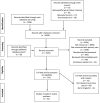Supporting bereavement and complicated grief in primary care: a realist review
- PMID: 33653707
- PMCID: PMC8278512
- DOI: 10.3399/BJGPO.2021.0008
Supporting bereavement and complicated grief in primary care: a realist review
Abstract
Background: Bereavement can have significant impacts on physical and mental health, and a minority of people experience complicated and prolonged grief responses. Primary care is ideally situated to offer bereavement care, yet UK provision remains variable and practitioners feel uncertain how best to support bereaved patients.
Aim: To identify what works, how, and for whom, in the management of complicated grief (CG) in primary care.
Design & setting: A review of evidence on the management of CG and bereavement in UK primary care settings.
Method: A realist approach was taken that aims to provide causal explanations through the generation and articulation of contexts, mechanisms, and outcomes.
Results: Forty-two articles were included. Evidence on the primary care management of complicated or prolonged grief was limited. GPs and nurses view bereavement support as part of their role, yet experience uncertainty over the appropriate extent of their involvement. Patients and clinicians often have differing views on the role of primary care in bereavement. Training in bereavement, local systems for reporting deaths, practitioner time, and resources can assist or hinder bereavement care provision. Practitioners find bereavement care can be emotionally challenging. Understanding patients' needs can encourage a proactive response and help identify appropriate support.
Conclusion: Bereavement care in primary care remains variable and practitioners feel unprepared to provide appropriate bereavement care. Patients at higher risk of complicated or prolonged grief may fail to receive the support they need from primary care. Further research is required to address the potential unmet needs of bereaved patients.
Keywords: bereavement; community nursing; complicated grief; general practice; grief; primary health care.
Copyright © 2021, The Authors.
Figures
Similar articles
-
'A silent epidemic of grief': a survey of bereavement care provision in the UK and Ireland during the COVID-19 pandemic.BMJ Open. 2021 Mar 3;11(3):e046872. doi: 10.1136/bmjopen-2020-046872. BMJ Open. 2021. PMID: 33658262 Free PMC article.
-
Bereavement care in general practice: a cluster-randomized clinical trial.Fam Pract. 2013 Apr;30(2):134-41. doi: 10.1093/fampra/cms053. Epub 2012 Sep 10. Fam Pract. 2013. PMID: 22964078 Clinical Trial.
-
Promoting and supporting self-management for adults living in the community with physical chronic illness: A systematic review of the effectiveness and meaningfulness of the patient-practitioner encounter.JBI Libr Syst Rev. 2009;7(13):492-582. doi: 10.11124/01938924-200907130-00001. JBI Libr Syst Rev. 2009. PMID: 27819974
-
Sleep disturbances in bereavement: A systematic review.Sleep Med Rev. 2020 Oct;53:101331. doi: 10.1016/j.smrv.2020.101331. Epub 2020 May 21. Sleep Med Rev. 2020. PMID: 32505968
-
[Bereavement and complicated grief: towards a definition of Prolonged Grief Disorder for DSM-5].Riv Psichiatr. 2014 May-Jun;49(3):106-14. doi: 10.1708/1551.16903. Riv Psichiatr. 2014. PMID: 25000886 Review. Italian.
Cited by
-
General practitioner consultations for mental health reasons prior to and following bereavement by suicide.Soc Psychiatry Psychiatr Epidemiol. 2024 Sep;59(9):1533-1541. doi: 10.1007/s00127-023-02607-9. Epub 2024 Feb 6. Soc Psychiatry Psychiatr Epidemiol. 2024. PMID: 38321295 Free PMC article.
-
Follow-up of grieving families in general and family medicine: a cross-sectional study on the practices and attitudes of family doctors.Fam Med Community Health. 2025 Aug 24;13(3):e003296. doi: 10.1136/fmch-2025-003296. Fam Med Community Health. 2025. PMID: 40854614 Free PMC article.
-
Bereavement care during and after the COVID-19 pandemic.Br J Gen Pract. 2021 Apr 29;71(706):198-199. doi: 10.3399/bjgp21X715625. Print 2021 May. Br J Gen Pract. 2021. PMID: 33926868 Free PMC article. No abstract available.
-
What does 'good' palliative care look like for children and young people? A qualitative study of parents' experiences and perspectives.Palliat Med. 2023 Mar;37(3):355-371. doi: 10.1177/02692163231154300. Epub 2023 Feb 24. Palliat Med. 2023. PMID: 36825577 Free PMC article.
-
A survey of palliative care domains and the palliative care provision confidence of Thai family practitioners.BMC Palliat Care. 2023 Oct 5;22(1):147. doi: 10.1186/s12904-023-01272-8. BMC Palliat Care. 2023. PMID: 37794416 Free PMC article.
References
-
- World Health Organization ICD-11 for mortality and morbidity statistics (version: 09/2020). 6B42 Prolonged grief disorder. https://icd.who.int/browse11/l-m/en#/http://id.who.int/icd/entity/118383.... [10 Mar 2021];
LinkOut - more resources
Full Text Sources
Other Literature Sources


